The German Korriphila HSP 701 was the masterwork of the Czech designer, Edgar Budischowsky. Budischowsky had previously designed the TP70 .22 and .25 caliber pocket pistols, but the HSP 701 was a different animal entirely. This was a full size centerfire handgun primarily intended for personal defense and built to the absolute highest standards of excellence. The patent for the HSP 701 design was granted in 1979, and production started in 1984.

4” barrel HSP 701 serial number 23 from 1984 – first year of manufacture – owned by bac1023
The HSP 701 handguns were hand built to order on a custom, one at a time basis in Heidelberg, Germany. Budischowsky’s goal was to build the highest quality pistol in the world with reliability and accuracy to match. The priorities were simple. It was build quality and performance. All other considerations were secondary or, in the case of cost, barely a consideration at all. This was not a handgun built for any country’s military or police and was certainly not a production gun. They were built in extremely limited numbers (less than 30 per year) to the specifications of their customers.
1984
Please join us for a quick travel back in time. 1984 is a period of rapid change for handguns and handgun technique. For police officers, the transition from revolvers to semi-autos is close to complete. The further transition from single to double stack capacity is a foregone conclusion, but the age of the polymer pistol is just now dawning.
Although the Browning Hi Power dates back to 1927 and the Smith & Wesson 39 back to 1955, the 9mm semi-auto pistol has been slow to be adopted by U.S. police. It wasn’t until the 1980’s that semi-autos began to outnumber revolvers in law enforcement holsters. In 1984, the infamous Miami FBI shootout is still two years in the future. At the time of the shootout, the FBI agents will be armed with S&W 459 9mm double stack and S&W .357 revolvers.
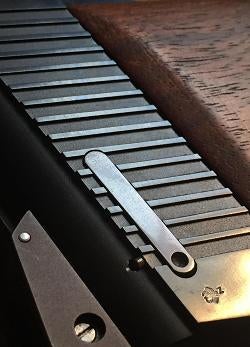
Bolt release
Meanwhile, the 1911A1 is still the official handgun of the United States military. The Beretta M9 will begin acceptance a year later in 1985 and the full roll out will not begin until 1990. A new polymer handgun, the Glock 17, had just been adopted by the Austrian military in 1982. The pinnacle of the 3rd generation Smith & Wesson 9mm pistols, the 5906, will not be introduced until 1989. Until then, the 459 introduced in 1980 is the duty 9mm of choice. In Germany, the Heckler & Koch P9S is still popular despite being discontinued several years earlier. German police are now properly armed with one of three outstanding single stack 9mms, the Walther P5, the Sig Sauer P6, and the intricate H&K P7.
Pistol technique is also rapidly developing. IPSC is founded in 1976, and Col. Jeff Cooper also founds Gunsite in 1976. By 1984, Col. Cooper’s influence on defensive pistolcraft is immense.
Into this era, a single stack .45ACP personal defense pistol of extreme quality with a crisp, short trigger pull and no external safeties made sense. The low bore axis and fixed barrel gave it added benefits in recoil management and accuracy, respectively. The caliber and capacity made the HSP a natural for American 1911 shooters.
The Pistol
Budischowsky’s Korriphila HSP 701 is a fixed-barrel roller-delayed blowback semi-automatic single stack pistol of his own design. The pistol has no external controls other than the slide release that also doubles as a decocker. Originally built in .45ACP, they could additionally be ordered in 9mm Parabellum, .30 Luger, .38 Super, or .38 Special Wadcutter. We also understand that they could be ordered in calibers such as 10mm and 9mm Ultra. The majority were built in .45ACP with fewer in 9mm. To the best of our knowledge, very few, if any, of the other calibers were ever built.
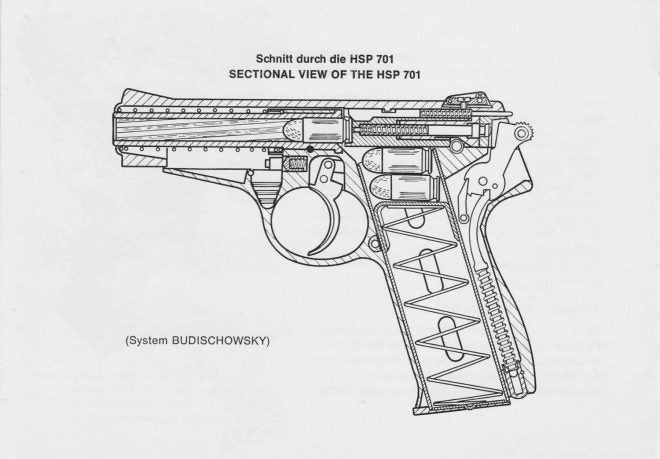
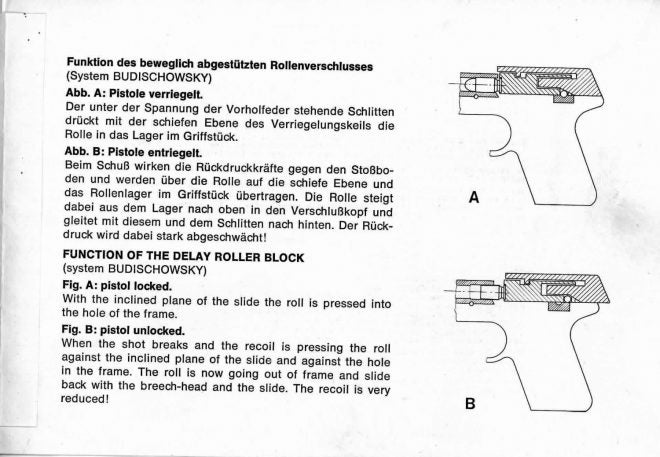
Budischowsky action
The customer could choose between a 4 inch or a 5 inch barrel. The customer could also choose the standard traditional DA/SA setup or choose to order a single action only or double action only version. Controls and sights could be customized as well. Lastly, the customer had a choice of a beautiful blued finish, silver finish, or in the case of the special Odin’s Eye model, Damascus steel.
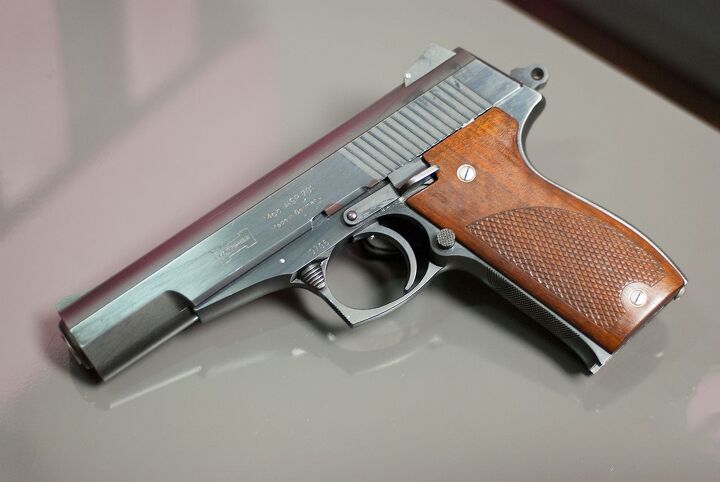
5″ barrel blued finish HSP 701 serial number 796 built in 1986 owned by Yuns
Interestingly, although Budischowsky built the pistols in Germany, the HSP 701 was clearly intended for the U.S. market. It was designed around the .45ACP, and the test targets were shot at 25 yards rather than 25 meters. These were both curious choices for a European-bred pistol. Even the size and shape of the original 4” HSP mimicked the old Smith & Wesson 39. The manual extolled its virtue as a big bore pistol that could be carried safely with a round in the chamber. It was a bespoke defensive pistol for the American shooter. Col. Cooper made highly approving note of the HSP 701 after shooting two samples. Ken Warner in Gun Digest quoted Col. Cooper opining, “These pistols were each a pleasure. The pulls were clean and sharp, the feel fine, the sights just right. In a 35-ounce gun, of course, the recoil was light.”
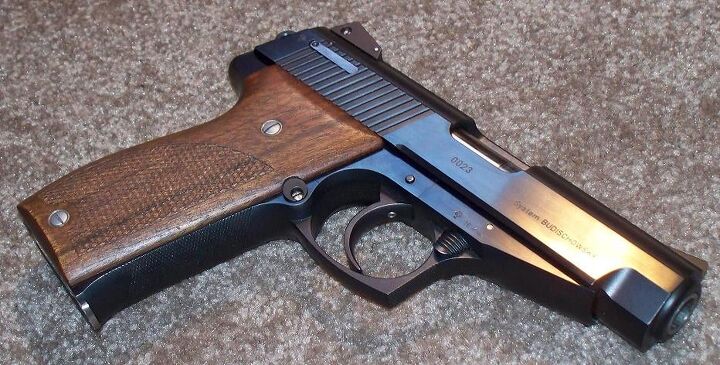
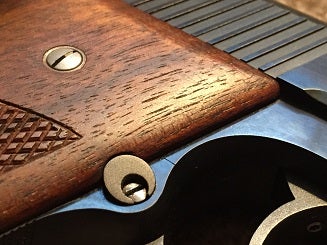
Shortly after production of the HSP began, Walter Rickell tested Korriphila HSP 701 number 0017 owned by Irv Stone of BarSto for a 1985 edition of American Handgunner. He described it as a “very well made and designed piece” with “flawless machining and polish.” There were claims that approximately 30 HSP 701 were built per year, and the German magazine Visier reported in 1990 that approximately 400 Korriphila pistols were ever manufactured. We are only aware of the sub-100 serial block (1983-1985), the 700 series (1986), the 800 series (1987), the 900 series (1992) and the 1200 series, so the total tally of 400 units seems a bit optimistic to us. The models we own that are pictured here are the 4” barrel .45ACP in traditional DA/SA built in 1984 and a 5” barrel .45ACP in traditional DA/SA built in 1986.
The Korriphila HSP 701 was built for .45ACP from the start and was not a 9mm that had to be “scaled up.” This is a large framed handgun, unlike many other European pistols. Budischowsky would later design the PP10 Minigun pistol around the 10mm cartridge.

5” barrel HSP 701 from 1986. This is a 700 series pistol. The bluing is almost black but shines in good lighting
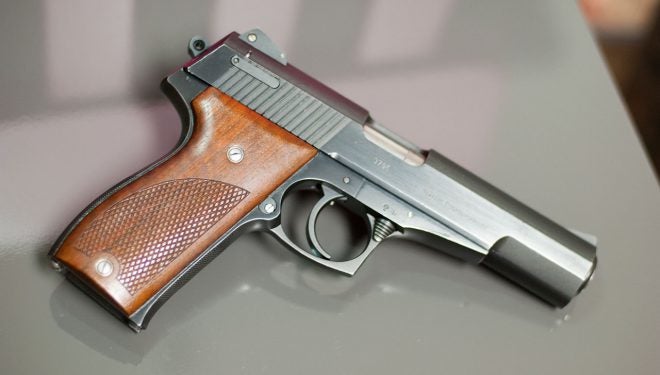
Detail and Quality
From a sheer parts and build quality perspective, they are two of the best pistols we have ever owned or even handled. All parts are cut from the finest solid billet steel and are of virtually unmatched form and quality. The attention to detail and steel work is simply off the charts, and we tried to capture this attention to detail in our photos.
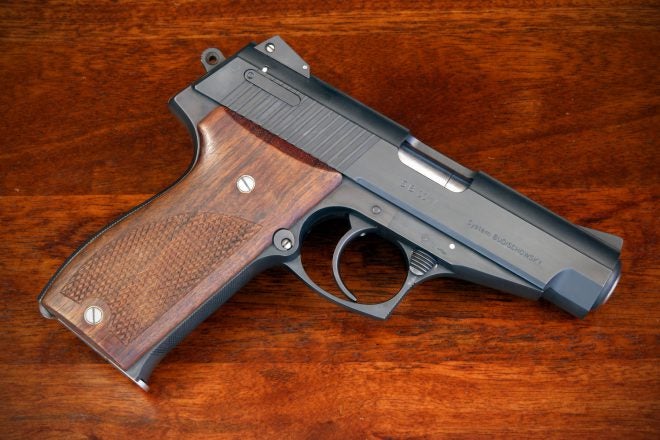
HSP 701 owned by lifesizepotato; photo used with permission
What struck us the most was just how tight the gun is. Nothing moves that isn’t supposed to move. There is no slide to frame play at all. Racking the slide takes some effort. Once the slide is back, there is still no movement. You can shake the gun vigorously and there is no rattle. It honestly feels like one piece of steel in the hand. It is, in our opinion, the very finest semi-auto to ever come out of Germany.
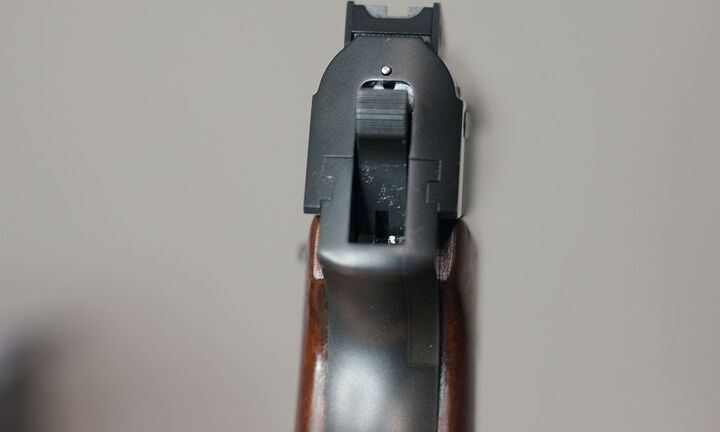
Slide to frame fit

Korriphila Ulm nitro proof mark and date code
Bac1023 is a collector of semi-custom and custom 1911s and he is not sure he even owns a custom 1911 that feels like this. Even the takedown process feels secure and precise. When field stripping the 4” HSP 701, the two take down levers are not just spring loaded, but actually lock into the downward position with a distinct “click” and all the security of a bank vault. They are not released until the slide pushes down a rearward lever upon going back onto the frame. Internally, the gun is a marvel of craftsmanship with everything fit like a Swiss watch. Externally, what looks like checkering at first glance, are actually fine cross-hatched lines on the front strap, back strap, and trigger guard.

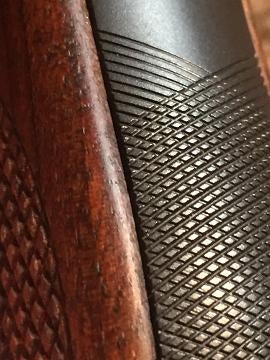
The roll marking was clearly done by hand and is amongst the nicest we have seen. The bluing is semi glossy and beautiful to look at. It’s that perfect middle ground between matte and high gloss blue. This is obviously the work of a master gunsmith producing a gun without limitations of a budget or the requirements and stipulations of a higher power. It’s easy to see why Jeff Cooper spoke so fondly of the HSP when Budischowsky first started production. It’s a spectacular piece of almost otherworldly precision, refinement, and class.
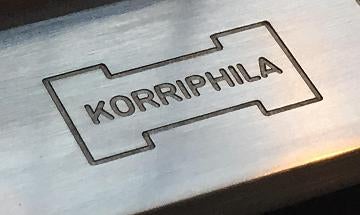

The Numbers
Make no mistake, however. This is not just an ultra high end show piece. The design was meant for serious defensive use. As noted earlier, the HSP 701’s Budischowsky system is a roller-delayed blowback, similar to Heckler & Koch’s P9S. However, unlike the two side mounted rollers of the H&K. The HSP 701 uses a single roller in the bottom of the bolt.
The barrel is fixed, the bore axis relatively low, and the ergonomics superb. The perfectly positioned DA trigger has a short, incredibly smooth travel and reset. The SA trigger is clean and precise with very little take up and absolutely zero creep. The slide top is flattened and finely serrated. The oiled wood grips are tastefully cross-hatched in a pattern similar to the metalwork.

The DA/SA version is designed to be carried with the hammer down and to have no controls other than the slide release which also doubles as a decocker. The only safety is a firing pin safety and hammer block which is actuated by pulling the trigger.
The slide release/decocker is very interesting. In the earliest models, decocking was accomplished by pressing the slide release down further than normal. You could release the slide without decocking but still use the slide release as a decocker by pushing harder. In later models, you would need to thumb the hammer as well in order to decock.
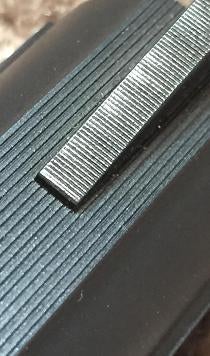
In these later models, you keep your finger off the trigger then pull back the hammer and push down the slide release and the hammer will be safely released and you can let it come forward. One additional note, if the slide is forward and you hold down the slide release it will prevent the slide from being racked. The slide will be locked closed so the slide will only be able to move a millimeter or so.
While not intended for competitive shooting, their fixed barrels and tight operating clearances make the Korriphila quite accurate for a defensive pistol. The Korriphila came with 25 yard 5-shot Ransom rest test targets. One owner has one that is about 30mm (1.18 inches) center to center. The authors have also seen one that was 21mm (0.83 inches) center to center. In 1990, Visier, the German gun magazine, tested 3 HSP 701s. The 5″ 9mm’s best group was 22mm (0.87 inches) at 25 meters. The 4″ 9mm’s best group was 31mm (1.22 inches), and the 5″ 45’s best was 44mm (1.73 inches).
As can be imagined, these handguns are heavy, especially for their sizes. Despite having a relatively short barrel and slide, the 4” version weighs in just under 40oz empty and is heavier than many full size, all steel 1911s.
Trigger Pull:
 The average DA pull is a super smooth 9.1 lbs and the SA pull a crisp 4.5 lbs.
The average DA pull is a super smooth 9.1 lbs and the SA pull a crisp 4.5 lbs.
Full DA trigger travel: 0.770 inches (19.6 mm)
Slack to take up in DA: 0.110 inches (2.8mm)
Full SA trigger travel: 0.288 inches (7.3mm)
First stage travel: 0.226 inches (5.7mm)
Second stage/break 0.062 inches (1.6mm)
Reset is right back at the second stage wall. It is a 0.062 inch reset (1.6mm) so just barely under 1/16 of an inch for the reset. There is also an overtravel screw at the base of the trigger.
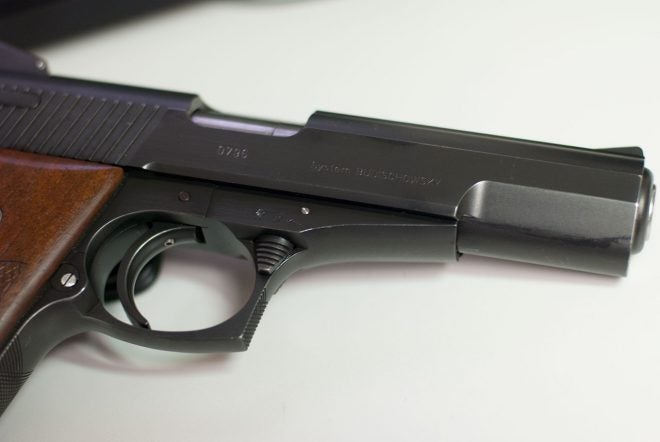
Physical Dimensions:
Height (bottom of front edge of pistol to stop of slide not sights): 5.38 inches
Length for the 5” version (muzzle to back of beavertail): 8.25 inches
Barrel length approximately: 5 inches
Grip width at widest point: 1.35 inches
Grip width at narrowest point: 1.25 inches
Slide width: 1.00 inches
Slide width including slide release: 1.35 inches
Weight (5” version empty): 2.45 lbs (39.2 oz or 1.11 kg)
Weight (5” version with one unloaded magazine): 2.63 lbs (42 oz or 1.19 kg).


Loaded chamber indicator above the hammer
The 4” version displayed here is a very early pistol, dating from 1984 with serial number 0023. It’s from the first series delivered to the public from Budischowsky’s shop. The adjustable rear sight is shrouded much like some old S&W autos. The sights on the 5” version were set up for 6 o’clock hold.
Another interesting feature is the small silver dot above the hammer at the back of the slide. This is a visible and tactile loaded chamber indicator.
In addition to the myriad of custom options, there were undocumented design changes over the years. Here is a photographic comparison of the differences between bac1023’s 00xx series model and Yuns’ 7xx series model.


In addition to the pictured differences, the earlier models had a longer slide release, but by the 700 series they had short slide releases.
Shooting Impressions

The recoil is a bit snappy, as you can imagine of a blowback .45ACP. However, Budischowsky’s fantastic roller delay system does a tremendous job of taming the cartridge and its 230 grain projectile to easily tolerable levels. Additionally, the reasonably low bore axis does not allow for much in the way of muzzle rise and flip. The incredible preciseness of the gun is evident while you’re shooting it. Nothing extraneous moves while its cycling. It’s just a quick, sharp jolt backwards and then right back on point. The trigger reset is just outstanding.
From an accuracy standpoint, the HSP can hold its own against many of the two authors’ purpose built target pistols. Considering this was not the gun’s intended use, we found that quite impressive. We only ever shot ours with 230 grain ball ammo, but reliability has been 100% thus far. Given the high value and the fact that replacement parts are next to impossible to find, these are not pistols we put many rounds through.
Our friend, who runs a youtube channel under the name lifesizepotato, has a video of himself shooting his HSP 701, which gives an excellent view of the trigger and recoil when shooting. We have linked his video below:
Disassembly
As mentioned earlier, initial break down is done via two levers on either side of the frame, not unlike that of a CZ 52 or the very exotic Delta AR Top Gun. However, the slide does not lift off the frame in the same fashion. The slide must be pulled back and up and then forward over the fixed barrel in true blowback fashion and not unlike that of a Heckler & Koch P7.
How to disassemble a Korriphila HSP 701
First, remove the magazine and rack the slide and check to make sure no ammunition is in the pistol!
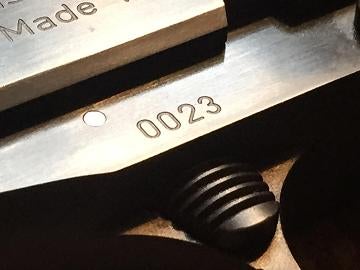
There are two ridged tabs along the sides of the front of the trigger guard. These are called Slide Holders or Schlitten Halter. Grip the tabs and pull down firmly. In older models (1984) like bac1023’s 4” pistol, the tabs will lock down due to the Arretierbolzen, which was deleted on later guns. In models after the first generation like Yuns’ 5” pistol (1986), the tabs will not lock down and you must keep them firmly held all the way down with one hand. At least one magazine notes that there is a steel pin to hold the tabs in later models, but, if such a tool exists, we have not seen it.
While you hold down the tabs with one hand, hold the frame firmly with the other hand, then with your third hand or prehensile tail pull the slide all the way back past the normal stop point then lift the back of the slide up over the back of the barrel and then ride the slide forward off the pistol. On a model like bac1023’s, the locking tabs make this easy. On later versions, like Yuns’, without locking tabs, this will take 3 hands or 2 hands and a way to hold the frame steady plus about half an hour of cursing and blistered and pinched hands.
When the slide is pulled up over the back. the pistol will look like this:

After you have the slide off it will look like this:
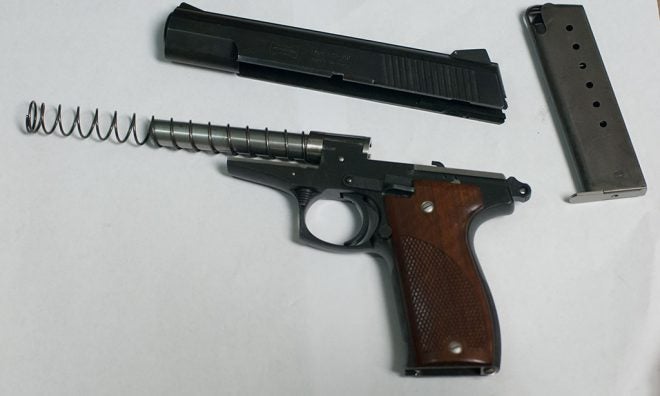
Here is the chamber
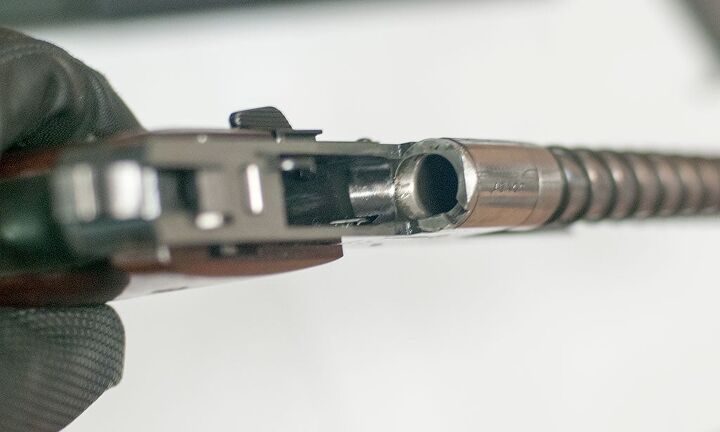
Here is the top of the frame. Notice the cut out indentation where the roller will sit. Also notice the extractor. The part on the right side next to the hammer is the part of the action which comes back to push the firing pin safety out of the way.
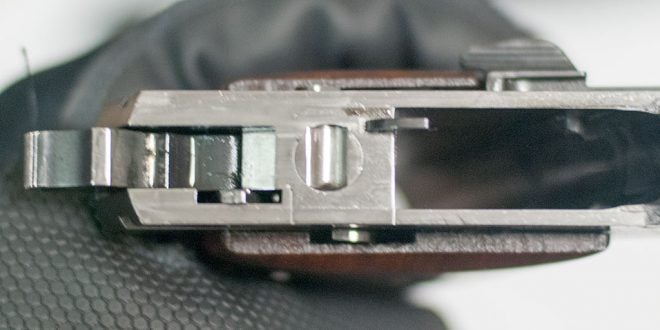
Here is the bottom of the grip. You can see the mainspring.

Here is the frame with the fixed barrel on it and the recoil spring around it. Notice the silver rectangle in the frame under the base of the barrel. This is the block that holds the slide on and that is lowered when the slider holder tabs are pulled down.
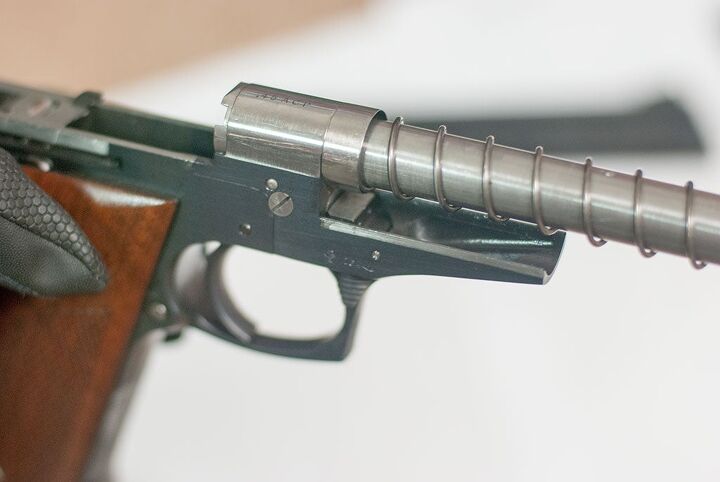
The recoil spring is attached to a ring around the barrel that slides right off.
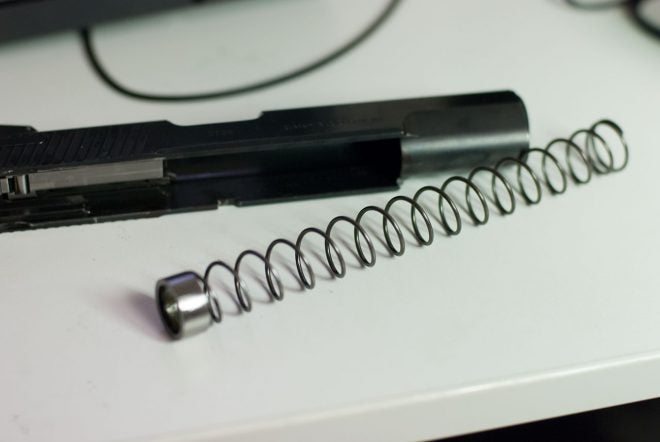
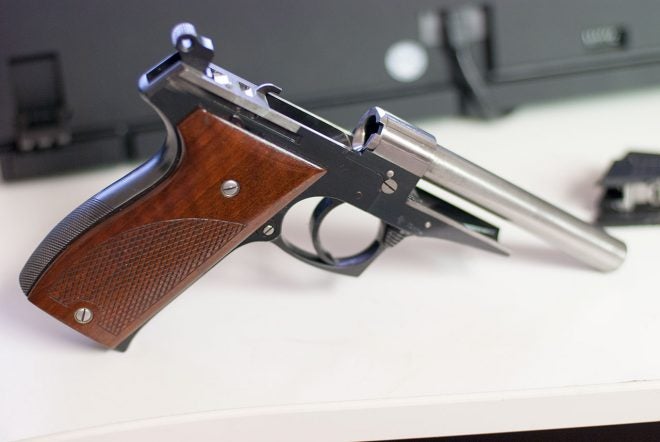
Here is the bottom of the slide. You can see the bolt assembly and at the very back the passive firing pin safety which looks like the firing pin stop on a 1911.
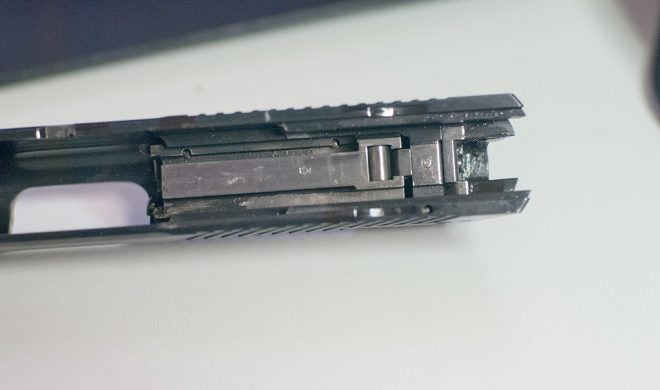

Even the finish on the interior of the slide is excellent
On the right side of the slide there is a bolt release that kind of looks like an extractor. Push in the bolt release at the dot with a non-marring tool. While you push it in then pull the bolt forward with your finger.
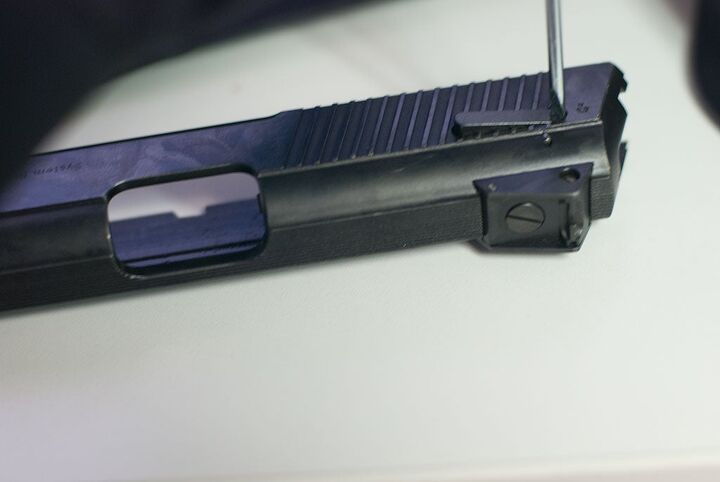
Bolt released and slightly pulled forward.
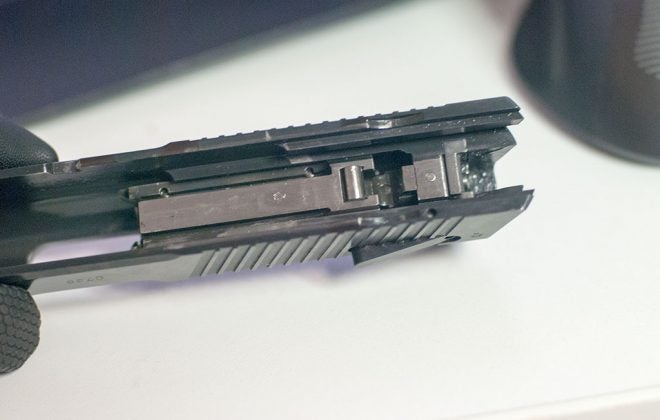
Bolt pulled further forward. You can see the firing pin which remains with the slide and doesn’t come off with the bolt. Note that the firing pin spring may stay inside the bolt or may stay on the firing pin. I prefer keeping it on the firing pin.
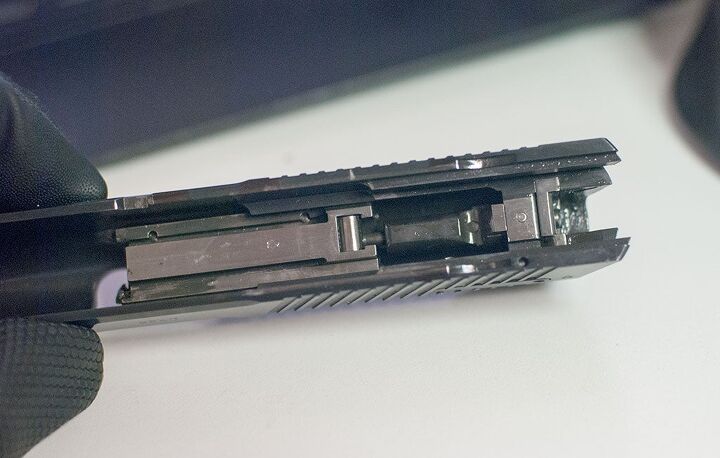
Bolt fully out. The pin on the bolt is the loaded chamber indicator which sticks out the back for a visual and tactile reference.
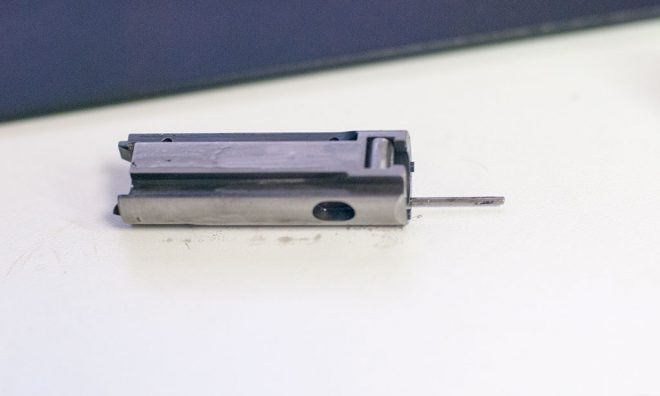
Bolt face. You can see the claw of the extractor at 10 o’clock and the loaded chamber indicator at 12 o’clock.
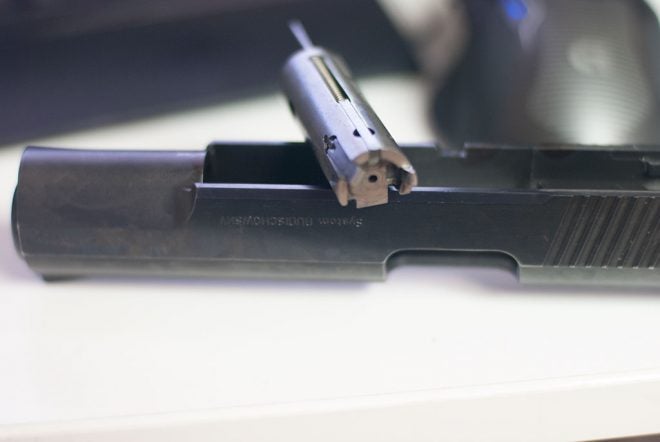
Top of the bolt showing the loaded chamber indicator spring.
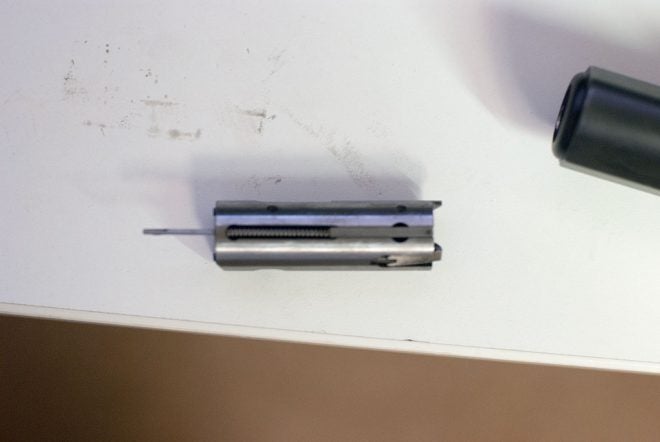
Bottom of the bolt showing the single roller for the roller delayed action.
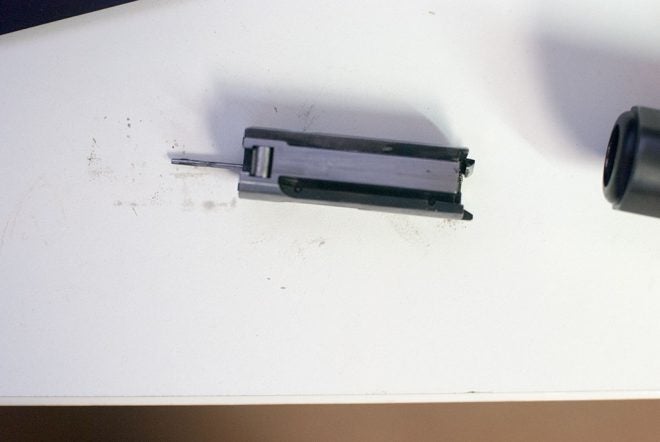
Firing pin and spring still in the slide along with the safety.

Push the firing pin safety down.
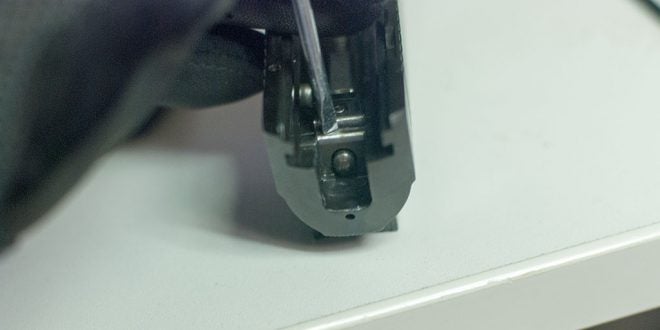
Then while pushing the firing pin safety down, push the firing pin in to release the firing pin safety which is held solely by the firing pin.
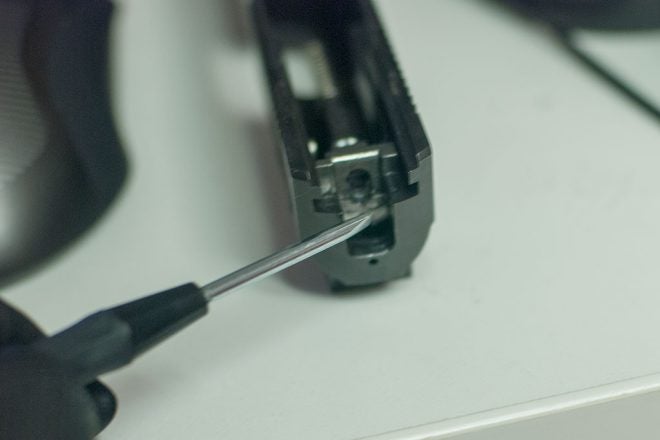
Now you can slide the safety up and out. Take care not to lose the tiny spring that pushes the safety down. Lubricate well with grease (not oil) because it needs to freely slide up and down. I use moly grease.
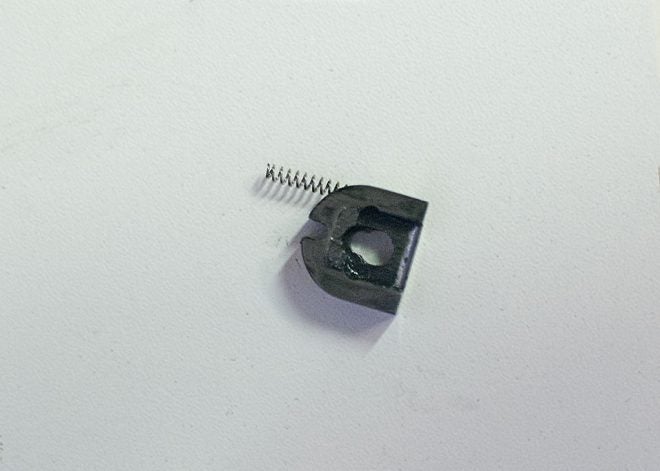
Now pull the firing pin out the back.
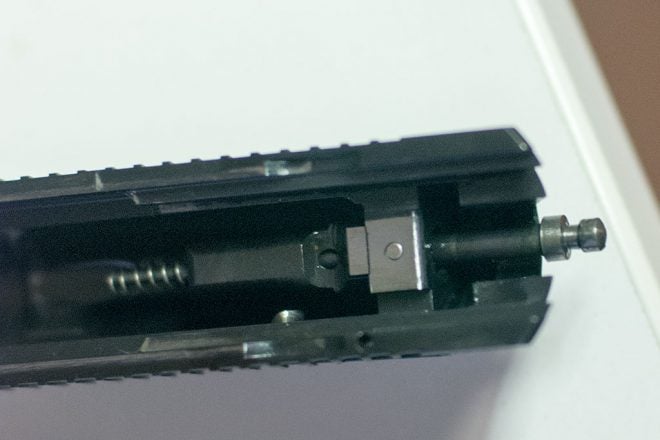
Bolt, safety and firing pin.
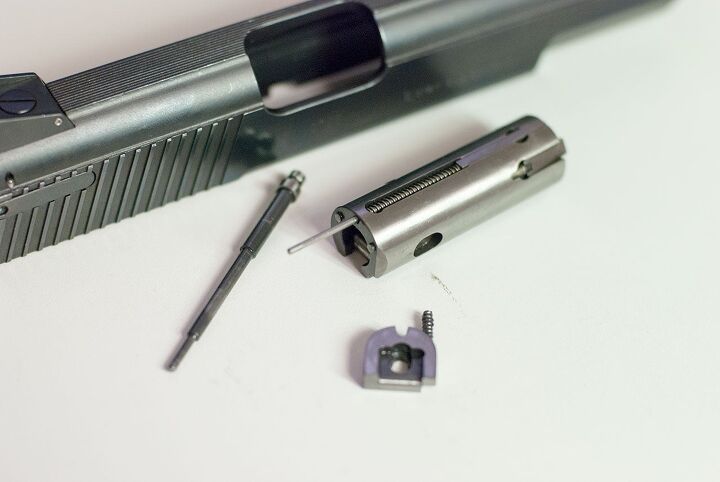
Reassemble by sliding the firing pin and spring in from the back, then sliding in the safety taking care to make sure the safety spring goes into the space inside the slot for the safety spring. Then allow the firing pin to snap back to lock in the safety. Then slide in the bolt, taking care to make sure the indicator goes into the correct hole and does not get bent, until the bolt snaps into place.
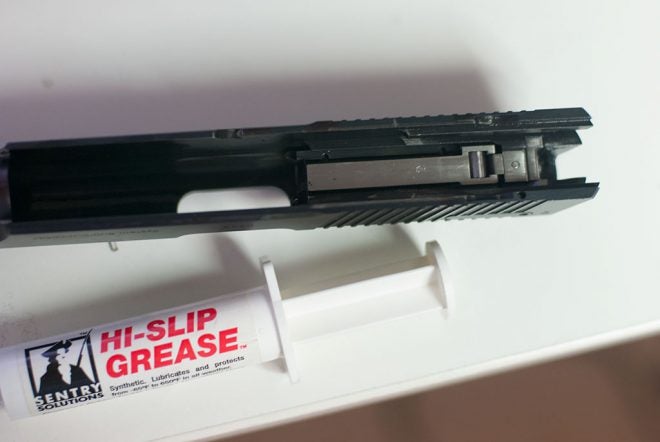
Now place the front of the slide over the front of the recoil spring and barrel. Pull down the locking tabs if your locking tabs lock into place. If your locking tabs don’t lock into place, you may have to pull down the locking tabs slightly but you won’t have to pull them all the way down. Pull the slide all the way back as far as you can then down over the back of the frame. you should hear the locking tabs snap back into place and then you can let the slide ride forward into position.
Assembled.
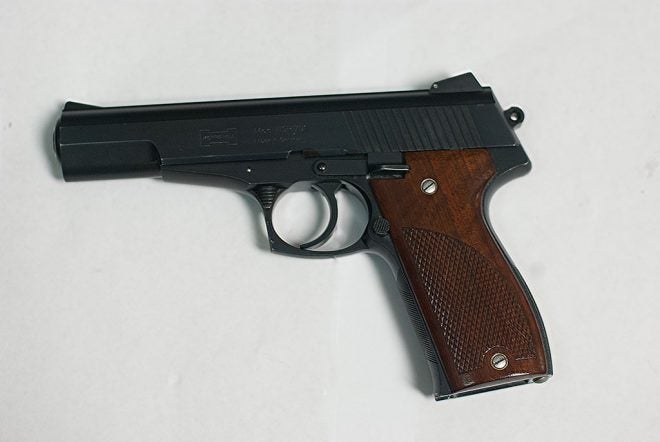
Slide locked back.

The underside of the slide when it is locked back shows the safety and you can actually remove and replace the safety from here even without disassembly.
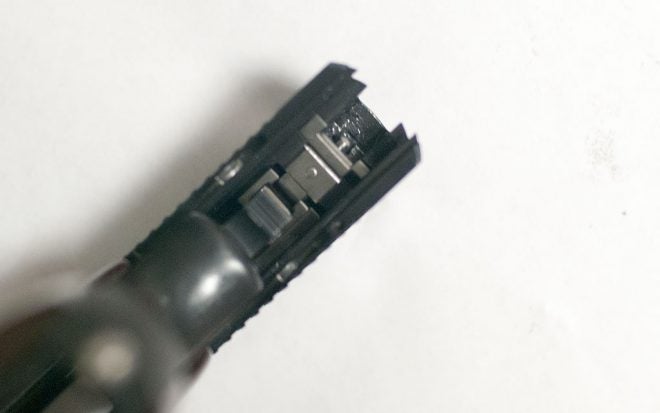
Pricing and Costs
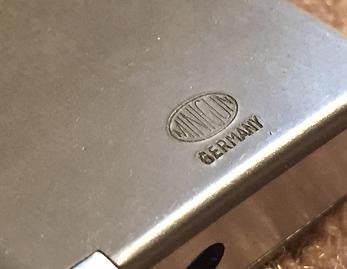
Even the magazines are of exceptional quality
As mentioned earlier in the article, the HSP 701 was a pistol built with little concern for cost. Likewise, asking prices throughout its history were not for the faint of heart. When the pistol debuted in 1984, the starting price was a staggering $2000. That may seem much more commonplace now, but in 1984 it was an incredible sum of money for a handgun. A then-new Colt Python was less than $500 to give you some perspective.
 Over the years, HSP prices rose with inflation and then some. The gun hasn’t been built in a long time and they are rare and hard to find, with far fewer changing hands. They generally bring $7000 to $10,000 on the used market in the U.S., depending on condition. At the time of this writing, a used HSP recently sold in an online auction for the top of that range. We don’t foresee those prices getting better any time soon. Are they worth the money? We think so, but we are hard-core collectors. From a purely objective and utilitarian standpoint, the answer is no. They clearly aren’t for everyone and never were intended to be.
Over the years, HSP prices rose with inflation and then some. The gun hasn’t been built in a long time and they are rare and hard to find, with far fewer changing hands. They generally bring $7000 to $10,000 on the used market in the U.S., depending on condition. At the time of this writing, a used HSP recently sold in an online auction for the top of that range. We don’t foresee those prices getting better any time soon. Are they worth the money? We think so, but we are hard-core collectors. From a purely objective and utilitarian standpoint, the answer is no. They clearly aren’t for everyone and never were intended to be.
Korth vs. Korriphila
Chances are that some of our reading audience has heard of German Korth revolvers. They have been around since the 1950’s. From the 1960’s through the present, Korth has built possibly the finest double action revolvers in the world. During the same time frame that Budischowsky was developing his HSP 701, Willi Korth decided to try his hand at building a semiautomatic handgun. It would finally debut in 1987, which was a few years after Budischowsky’s masterpiece hit the market.
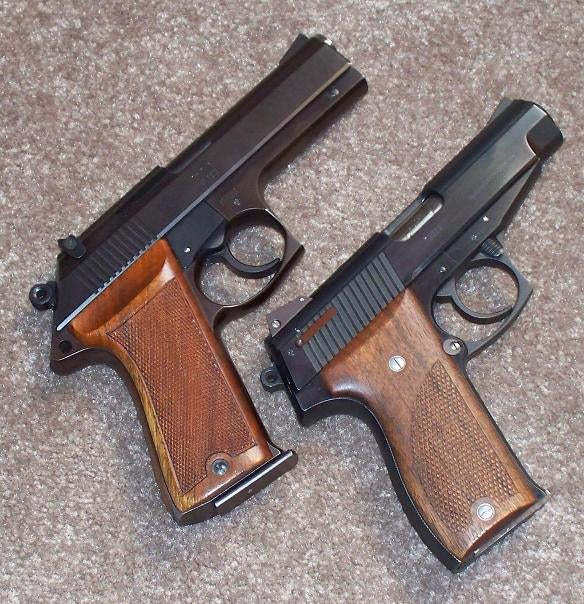
bac1023’s Korth autopistol and Korriphila HSP 701

Korriphila bolt
So how do these two titans compare when clashed? Well, comparisons are inevitable. They have many similarities. They were produced during the same time period. They were completely hand built by small, boutique German companies. They are both ultra high quality and extremely rare. Both are largely original designs to their respective developers. Both fetch about the same price in today’s market, and even the names start with the same three letters, causing confusion at times when being referred to over the years. However, that’s where the similarities end. The guns themselves are actually nothing alike from a design standpoint, which we think is obvious.

Recess in frame for roller
When it comes to parts quality, refinement, and attention to detail, we believe the two guns are on a level playing field. The Korth is built in similar fashion using the finest materials. From this standpoint, both pistols are way off the charts. In regard to the actual designs, the HSP has a clear advantage. Its roller delayed blowback system is simply a better performer than Korth’s forward mounted falling block locking system. As an owner of both, it is bac1023’s opinion that the Korriphila’s design is also superior from an ergonomic standpoint. It just feels like a much tighter and more purpose built piece of machinery than does the Korth.
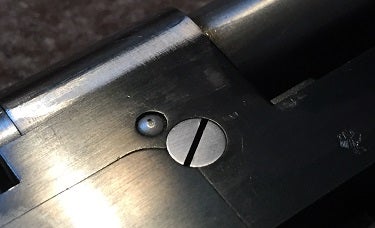
That’s certainly not to say that the Korth is loosely fit. It’s quite the opposite, in fact. However, the Korth is more a testament to the builder’s great prowess in ultra high quality, refinement, and exotic flair than it is a serious shooter. Granted, it’s an accurate gun, but it feels rather awkward and clumsy in hand compared to the HSP 701. Where the Korth has the advantage over most of the more (relatively) run of the mill high end pistols was the aforementioned attention to detail, parts quality, and refinement. When compared directly to the Korriphila, however, it absolutely does not have that advantage.
To summarize, we think Budischowsky’s entry wins the head to head comparison by a slim margin. Having said that, we feel largely inadequate judging two of the finest pistols on the planet.
Summary and Conclusion
So what is left to say? In reading the article, it’s obvious how much we love the Korriphila HSP 701. We are both students and collectors of high end pistols from all over the world. We have seen and owned our share over the years. Despite this background and familiarity, the HSP still impresses us to a very high level of enthusiasm.
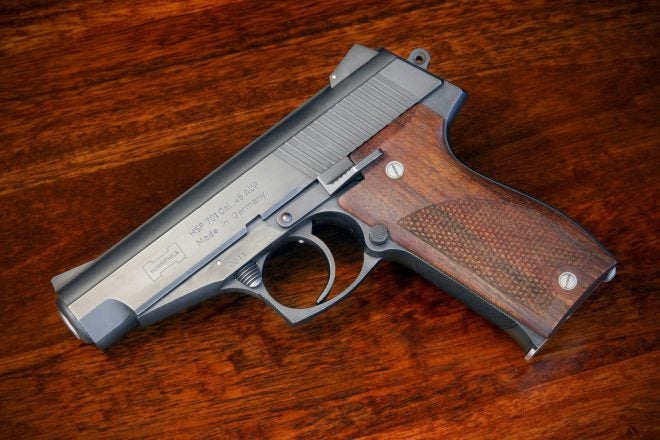
HSP 701 owned by lifesizepotato; photo used with permission
Bac1023 sums it up like this: In my eyes, this is the true pinnacle of quality, design, fitting, and refinement in handgunning, of which I’ve never seen an equal. Taking an objective stance, the two of us find it hard to put any gun ahead of Switzerland’s incredible forged Sig P210-6 from the late 1960’s and 70’s as the highest quality semi-auto pistol of all time. However, the Korriphila is right there in the mix with the pride of Switzerland. It really is that good.
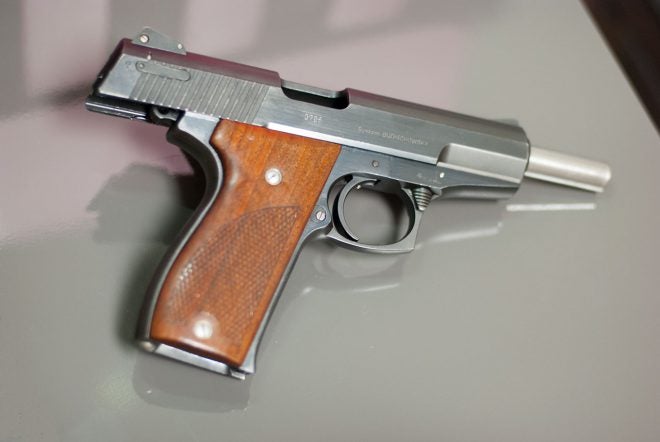
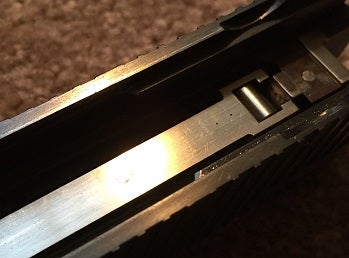 We tried our best to capture the essence of this handgun through our descriptions and pictures. While pictures don’t begin to do the pistol justice, we think you can see how well the HSP is put together. If there was ever a handgun in which you could realize the density, smoothness, and hardness of the steel without actually touching it, it’s the Korriphila. This is old world quality at its absolute best.
We tried our best to capture the essence of this handgun through our descriptions and pictures. While pictures don’t begin to do the pistol justice, we think you can see how well the HSP is put together. If there was ever a handgun in which you could realize the density, smoothness, and hardness of the steel without actually touching it, it’s the Korriphila. This is old world quality at its absolute best.
The HSP 701 is a bespoke defensive handgun of the highest quality. Speaking from purely utilitarian perspective , is it a superior defensive sidearm to the excellent Glock 19? Although of undeniably outstanding build quality, the HSP is heavy and low capacity compared to the modern polymer handguns. It is a Patek Philippe in a world of Casio G-Shocks. It compares much more logically to the true custom 1911s. The HSP is clearly not the logical utilitarian choice for a defensive handgun. However, it is still a handgun which we would trust for self-defense. To quote the late/great Obi-Wan Kenobi, the HSP is “an elegant weapon for a more civilized age.”
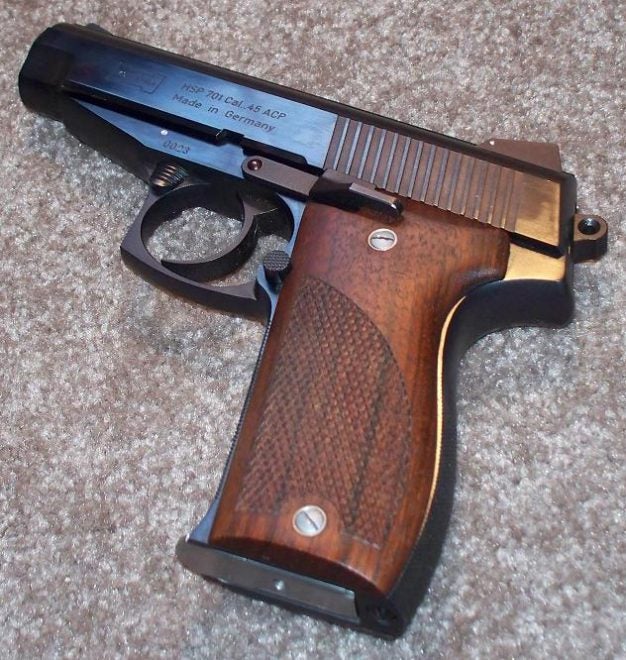
While we fully realize this isn’t a pistol that’s going to appeal to everyone in our audience, we wanted to shed some new light on Budischowsky’s masterwork, one of the greatest of all time, and we hope that Edgar Budischowsky’s work will not be forgotten.
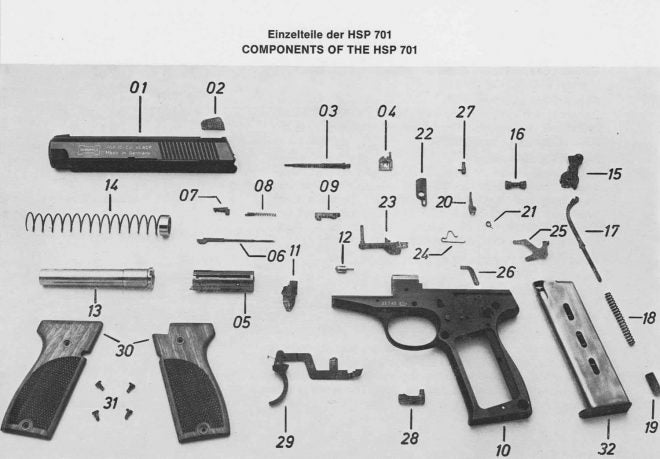
 Your Privacy Choices
Your Privacy Choices